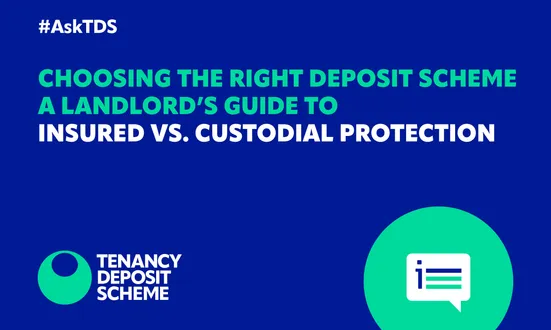With student season upon us, we wanted to use our #ASKTDS blog to answer common questions we receive from agents and landlords. Whether you’re an experienced student landlord or new to student lettings, the Tenancy Deposit Scheme aims to answer your burning questions related to student lets, and advise how to avoid potential deposit disputes at the end of the tenancy.
What are the differences between joint and individual tenancies, should I opt for one over the other?
When you rent out your property to multiple students, you have two primary options: joint tenancy or individual tenancy.
In a joint tenancy, all tenants sign a single Assured Shorthold Tenancy (AST) agreement. They are jointly responsible for the property and any potential issues such as rental arrears or damages. The tenancy deposit in this case is pooled together and associated with their collective obligations.
In an individual tenancy, each tenant signs their own AST agreement and is responsible for their own space within the property. This type of agreement is most common when renting out properties on a room-by-room basis. The choice depends on what is most suitable for your property and your tenants.
One of our students has put up a lot of posters and caused marks on the walls. Can I deduct for a full and professional repaint?
Blu-tac and nails are considered avoidable damage and therefore, are not considered fair wear and tear. In this case, if the tenant is not permitted to make any alterations to the property without first obtaining the permission of the landlord, then you will be able to submit a deposit deduction. If the tenant did get permission to alter the property in any way to include adding fixings to the walls, the tenant should be able to provide written evidence of this permission in support of their statement. Assuming the walls were freshly painted prior to the student moving in, you would likely be awarded compensation. It is essential that your tenants are aware of the obligations placed on them by the tenancy agreement. Highlight key dos and don’ts at the beginning of the tenancy, so the students are aware of what’s expected of them.
I’ve had a student leave their tenancy before the end of their contract, are they still liable for paying rent?
Early termination of a tenancy can occur when students leave the property before the end of their course or the tenancy agreement. In cases like this, the student will remain liable for the rent until the end date stated in their contract. The landlord however, may agree to end the tenancy early if a suitable replacement tenant can be found.
One of my students is in rental arrears, can I get this back through their deposit?
In cases where rent is still due at the end of the tenancy, the landlord is entitled to enforce the tenancy contract and can use the deposit to cover the unpaid rent. However, a more cost-effective and faster solution may be to negotiate a payment plan with the students and encourage them to seek financial support from available university hardship funds. At TDS, we provide our customers a free mediation and conciliation service for issues just like this. Please visit TDS Resolution to find out more.
How to avoid student-related deposit disputes
- Be sure to conduct reference checks on all of the tenants, or request a reference from the university if they are coming straight from the halls.
- Lay out your expectations with the student tenants at check in, ensuring they understand any special clauses in the tenancy agreement, and highlight important areas such as garden maintenance.
- Provide clear explanations. It may be your tenant’s first time living independently, so providing a helpful move-in pack explaining where things are, how to use the appliances, the signed inventory, and how to avoid damaging the property will protect you from disputes.
- Carry out a detailed inventory. Before your students move in, ensure you have a detailed inventory of all your fixtures, fittings, contents, and décor. Have all your tenants sign this inventory at check-in, confirming you are all in agreement.
- Include photos and thorough descriptions of the condition of each item in the inventory. Remember to supply dated photos and detail exactly which room is photographed. TDS comes across many images we can’t piece together in student let disputes, so clearly labelling each room is beneficial.
- Conduct mid tenancy inspections on a regular basis – usually every 6 months – and have them written into your tenancy agreement.
- Keep in touch. We find that the tenancy is less likely to end in dispute if the agents and tenants have a good relationship and they’ve resolved any issues during the tenancy. Our mid-tenancy mediation service, TDS Resolution, can help with problems during the course of the tenancy, and help sustain it.
- Supply the right evidence. We evaluate disputes based on the evidence we receive, so be sure to include check-in and check-out inventories, condition reports, pictures, invoices, and receipts. When we find the claim is reasonable, TDS will reach out to the tenant, advise them of the likely outcome and ask if they want to make any offers of settlement. Want to find out if your claim is likely to be successful? Try our free disputes chatbot.
- Many landlords have found that using our Deposit Deductions template to clearly outline the deductions you wish to make from the tenant’s deposit is very effective in coming to an agreement.
- End of tenancy reminders. Prompt your student tenants to review the inventory and return the property in the same condition – and to the same standard of cleanliness – as it was at the start so that check-out goes smoothly.
Renting to students can be a rewarding experience, but it does come with its own set of unique challenges. From handling premature termination of tenancies and managing end-of-tenancy challenges, you have a lot to consider.
By following our guidance and using the landlord deposit protection services offered by the Tenancy Deposit Scheme, you can safely navigate these challenges and maintain a positive relationship with your student tenants.
Protect your deposits with the Tenancy Deposit Scheme
Protect yourself and your student tenants with the government-approved deposit protection scheme, the Tenancy Deposit Scheme.
We offer free deposit protection in our Custodial scheme, and the lowest rates in our Insured scheme.
Other news stories


